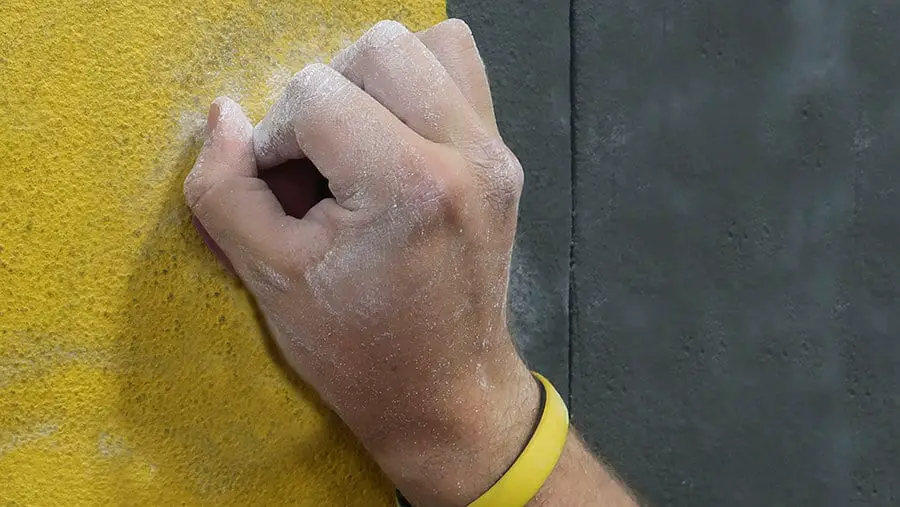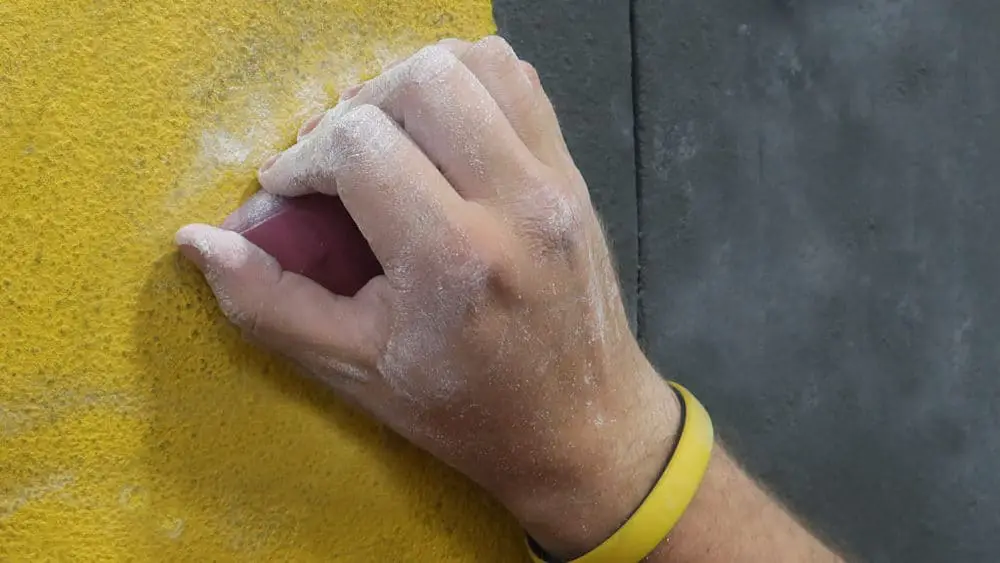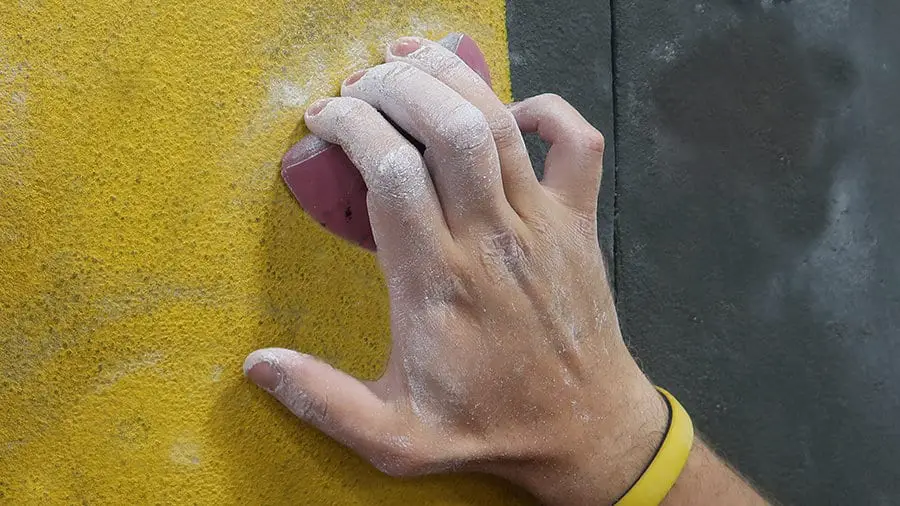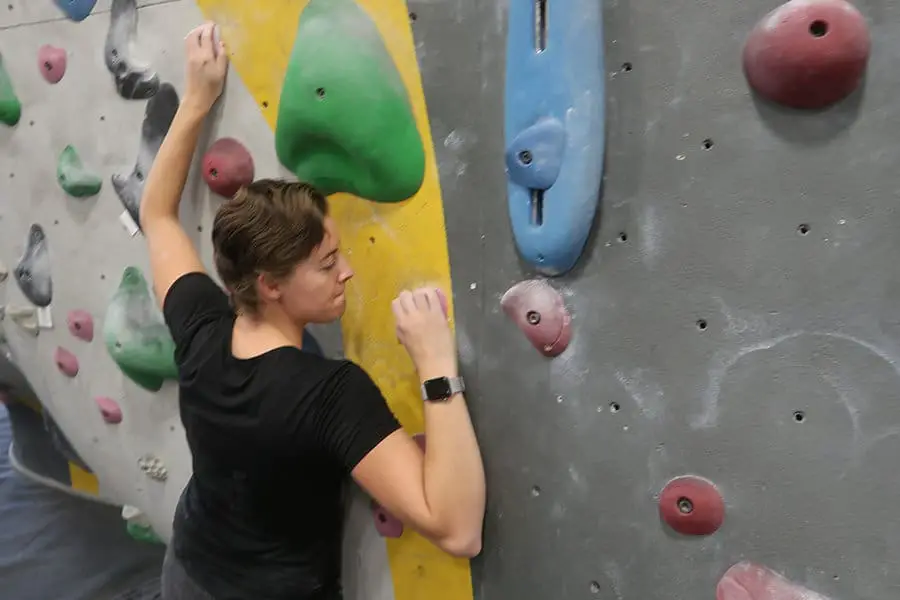A friend of mine who just started to climb told me that he prefers using handholds that are big enough for his entire hand to grasp because small holds were too difficult to grip and it made me think about crimping and crimp holds.
Crimp climbing, also known as crimping, is a climbing grip where your fingertips are the only thing that touches a crimp climbing hold. Crimp holds are small holds that only have enough space for fingertips. These types of climbing holds are usually on more advanced climbs.
Due to the amount of tension in your finger and hand tendons, crimping is one of the most common climbing hold types that can cause injury. However, it is also one of the most common climbing hold types in more advanced climbs so it is important to learn how to use them.
Crimp Climbing
Crimp climbing, also known as “crimping” can be edge handholds large enough for multiple fingers tips or just one or two fingertips.
According to a study that looked at “biomechanical properties of the crimp grip position,” three times the force applied at the fingertip during a crimp grip position compared to a sloper handhold during a warmup, making you more likely to get injured.
If you are crimping, pay attention to how your hand and wrist feel. If they become sore or hurt, stop climbing and allow the tendons to heal. If you continue to climb, you are at a higher risk of damaging your tendons and you may cause long-term injury.
Crimping is commonly broken into three different grip types based on the angle of your fingers and the location of your thumbs called full, half and open crimp.

Full Crimp
A full crimp is when your fingers on the crimp hold are at a full arch with your fingertips/finger pads and your thumb clasps on top of the hold. Climbers who are just starting to learn crimp climbing often use this handhold position because it has the additional strength from your thumbs. A concern about full crimping, however, is that it causes the most strain and it is easier to get injuries with full-crimp grips. Full crimps engage the entire hand and frequently cause climbers to rely too much on the strength of the grip instead of the distribution of their weight causing strain in the tendons that can be damaging short term or long term.

Half Crimp
A half crimp climbing grip is when your fingers are at a full arch with your fingertips/finger pads on top of the hold but your thumb is to the side of the grip and isn’t being used. This is the most common crimp position as it allows you to push down and keep your fingers in a locked position. Compared to an open crimp/drag hold, this handhold position allows you to continue using the handhold even as you move above the handhold. Though this type of crimp is safer to use than the full crimp, you should still pay attention to how your hand and wrist responds to movements and be cautious of overuse and straining your tendons.

Open Crimp/ Drag Grip
The safest way to use a crimp hold is with an open crimp, also known as a drag grip. Unlike the other two types of crimp grips, full and half crimps, your fingers are not at a full arch and the only thing above the handhold are your fingertips. Because of the minimal strain on your hand tendons, this is the safest of the crimp grips and should be used as much as possible on crimp handholds.
How To Make Crimping Easier – For Beginners
If you are just starting off in climbing or have been climbing for a short while, you may have found yourself avoiding crimp-heavy climbing problems.
This is a very common occurrence and you are not alone. However, if you don’t practice crimp climbing routes, then it will be more difficult to continue progressing and it will limit the problems you are able to do.
Here are two things you can focus on as a beginner to make crimping easier and help you on your way to becoming a better climber and help open doors for more routes.
Move Your Weight / Center of Gravity
When it comes to crimping, one of the easiest things you can do is move your weight to be in the opposite direction of the crimp handhold. The pulling movement will make it easier for you to use an open crimp.
Rely On Your Feet
Sometimes the footing on crimp climbing routes makes it impossible to put all of your weight in your feet/legs (especially overhanging routes). However, most climbs have footholds that will make it so you can put your weight on your feet. If you are having a hard time putting the weight in your feet/legs, reposition them so that your center of gravity is directly above your feet. This will make it so that the crimp holds are mostly for balance and less for holding your body weight.
3 Ways to Train for Crimp Climbing
Since crimping is very hand intensive, a lot of these training suggestions are for hand strength. With hand strength and learning how to leverage your leg strength, crimp climbing will become much easier.
1. Grip Donuts
Grip training is relatively basic and allows you to build hand strength quickly and conveniently. I prefer training with grip rings made of rubber instead of the grip handles that are more publicly known. Grip rings have different levels of weight training and they are completely quiet compared to grip handles that have a spring that squeaks every time you squeeze it.
Exercise Outline:
- Do the following on each hand 2-3 times per day with a grip trainer that is difficult to close. If this exercise is “too easy” then use a stronger grip trainer
- Close the grip trainer quickly and slowly open the grip trainer (as slow as you can) – repeat 7-10 times on each hand
- Quickly close and open the grip trainer as many times as you can until you max out (meaning that you are so exhausted that you can’t close the grip trainer any more)
2. 5-Second Rule
This training activity is good for all types of climbing holds and it is especially good for crimp holds because they require so much more focus compared to other types of holds.
- Find an area that has a lot of crimp handholds – it doesn’t have to be one route with all of the crimp holds, just an area that you can get to the holds easily
- Climb the wall while trying to only use crimps to get up the wall
- Hold onto the crimp climbing hold for 5 seconds before moving your hand to another hold – the easiest way to do this is by leveraging your footholds to hold the most weight before moving to the next hold
3. Hangboarding
Hangboarding is one of the most popular training techniques used by climbers, but beginner climbers should beware. Hangboard training is one of the easiest training regimens to get hand injuries from so if you try hangboarding pay attention to the way your hands feel and stop if you feel pain. Start with two workouts a week with a couple of days rest in between. Once the training becomes too easy, it is usually ok to move up to three workouts a week, but no more.
Exercise Outline:
- Start with a 15-minute warm-up targeting your hands, wrists and arms
- Identify 3 different crimp grips that you want to train with on the hangboard
- With the first crimp grip – hang for 10 seconds, 5 seconds off – repeat 5 times
- Take a 3-minute break
- Start the second crimp grip- hang for 10 seconds, 5 seconds off – repeat 5 times
- Take a 3-minute break
- Start the third crimp grip- hang for 10 seconds, 5 seconds off – repeat 5 times
3 Reasons Why You Should Love Crimps
- Crimp climbing can be extremely rewarding, especially compared to other climbing holds when you see yourself improving and when crimping becomes easier.
- Crimps are one of the most common holds in indoor and outdoor climbing so being good at crimp climbing will make it so you can do more climbs (and it makes you look good because plenty of climbers struggle with crimp climbing).
- Because crimp climbing is so difficult, climbers are more likely to review the entire climb and work out the problem before getting on the route, which will give you more experience planning your climbs and make you a more competitive climber.
3 Reasons Why You Should Hate Crimps
- Over crimping can cause short and long-term injury including chronic pain so it is important to listen to your body and stop climbing if you feel pain in your hands and/or fingers.
- Crimp handholds are usually too small to take breaks on so if you’re tired, you don’t have a choice but to keep climbing until you get to a handhold that is easier to grip and take a break on.
- Crimp climbing is one of the biggest barriers to increasing your climbing grade capability so if you can’t crimp climb, you’re more likely to plateau in your climbing capabilities.
Conclusion
Crimping is a climbing grip that is used when a climbing hold is too small to have anything but your fingertips on the hold. Crimp climbing is one of the most difficult types of climbing/climbing holds and most hand injuries are caused by over-crimping but it can also be very rewarding when you are able to use them. If you want to get better at crimp climbing, it is worth training your grip strength as well as trying training programs such as the 5-second rule outlined above.
More About Training for Climbing:
- How To Climb More Often Without Getting Injured | Tried And Tested Methods For Recovery
- Lower Body Mobility And Flexibility Challenge
- Neglected Techniques Necessary For V4-V5 Progression
- 17 Footwork Drills For Climbing
- Mental Training For Climbing
- How Often And Hard Should You Climb To Get Gains?
- When Should You Start Hangboarding For Boulder’s
- Is Bouldering When Sore Bad?
- The Top 22 Climbing Techniques And Skills And How To Do Them
- 23 Tips For Climbing Slabs
- When To Flag In Climbing And How-To-Do It (With Videos)
- How To Learn Climbing Technique For Beginners
- What Should You Record In A Climbing Journal?
- Climbing Endurance: Muscle, Skin And Mental Training
- How To Deal With Fear Of Falling
- How Many Days Should You Climb Per Week?
- 5-10 Minute Warm-Up For Climbing
- What Is A Dyno And How To Do It
- What Is A Gaston In Climbing? Powerful Moves For Beginners
- Can Foam Rolling Improve Rock Climbing Performance?
- 7 Things Climbers Should Do On Rest Days For Better Performance
- When Do You Need A Rest Day?
- How To Climb Your Best – Pros And Cons Of Rest Days
- Static Vs Dynamic Climbing Movement: Pros And Cons
- 5 Habits For Healthy Climbing That You Haven’t Thought Of
- 5 Things To Improve Climbing Performance And Sustainability
- 10 Minute Workout Routines For Post Climbing Sessions
- How To Use Climbing Holds: Techniques For Improved Climbing
- A Guide For Climbers: Bouldering Drills 101
- 12 Easy Workouts To Increase Hand And Grip Strength For Climbers
- What Are Undercling Climbing Holds And Why Climbers Love/Hate Them
- What Is A Crimp In Rock Climbing And How To Train For Them
- 7 Common Mistakes in Rock Climbing For Beginners


